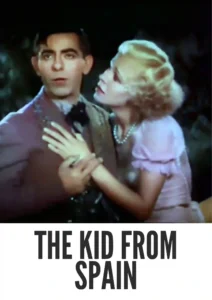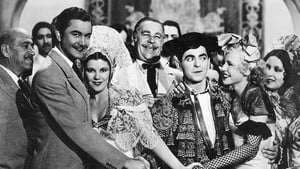Contact: info@alwanfilm.com
Video Sources 0 Views
- The Kid from Spain 1932 Full Movie


Synopsis
Table of Contents
ToggleReview: The Kid from Spain1932 Colorized – A Classic Comedy Revisited

Introduction
In the annals of classic cinema, few films capture the zany spirit and comedic brilliance of the early 1930s quite like “The Kid from Spain.” Directed by the talented Leo McCarey and starring the legendary Eddie Cantor, this film is a delightful romp that combines humor, romance, and musical numbers in a way that only the Golden Age of Hollywood could deliver. In this article, we delve into the vibrant world of “The Kid from Spain,” exploring its colorful characters, hilarious plot, and the impact of its recent colorized version on modern audiences.
Check The Full Colorized Movies List
Check Our Colorized Movies Trailer Channel
Understanding The Kid from Spain1932 Colorized: Director, Cast, and Genre
“The Kid from Spain” is the brainchild of Leo McCarey, a director known for his deft touch with comedy and musicals. McCarey, who would later go on to direct classics like “Duck Soup” and “The Awful Truth,” brings his signature style to this film, blending sharp wit with charming musical sequences.
The film stars Eddie Cantor, one of the most popular entertainers of the era, whose comedic timing and affable persona shine through in his portrayal of Eddie Williams, a college student who finds himself entangled in a series of hilarious misadventures. Cantor is joined by a talented supporting cast, including Lyda Roberti, Robert Young, and Ruth Hall, each adding their own flair to the film’s ensemble.
“The Kid from Spain” fits squarely within the musical comedy genre, a staple of early 1930s Hollywood. With its lively musical numbers, screwball antics, and romantic subplots, the film offers a perfect snapshot of the era’s entertainment landscape.
Exploring the World of The Kid from Spain1932 Colorized: Plot and Characters
“The Kid from Spain” follows the misadventures of Eddie Williams, a college student who is expelled for a prank and finds himself on the run after being mistaken for a bank robber. With the help of his friend Ricardo (Robert Young), Eddie flees to Mexico, where he masquerades as a famous matador to hide from the authorities.
As Eddie navigates his new identity, he encounters a host of colorful characters, including the beautiful Rosalie (Lyda Roberti), who becomes the object of his affection, and the bumbling bullfighter Don Juan (Noah Beery), whose antics add to the film’s comedic chaos. The plot unfolds through a series of humorous misunderstandings, slapstick gags, and lively musical numbers, culminating in a thrilling and hilarious bullfighting sequence.
The Art of Film Colorization
Film colorization, the process of adding color to black-and-white footage, has sparked debate among film enthusiasts and preservationists. Proponents argue that colorization can breathe new life into classic films, making them more accessible and appealing to contemporary audiences. Critics, however, contend that colorization can alter the original artistic vision and detract from the historical authenticity of the film.
The process of colorization involves painstakingly adding color to each frame, often using historical references and artistic interpretation to ensure accuracy. Advances in technology have made colorization more sophisticated, allowing for greater fidelity to the original film’s textures and tones.
Early Colored Films: A Brief History
The history of early colored films is a fascinating journey through the evolution of cinematic technology. From hand-tinted frames in the silent film era to the advent of Technicolor in the 1930s, filmmakers have long experimented with color to enhance storytelling and visual appeal.
Early experiments with color were often labor-intensive and costly, but they paved the way for the vibrant Technicolor musicals and epics that would dominate Hollywood in the following decades. These innovations not only transformed the aesthetic of films but also expanded the possibilities for cinematic expression.
“The Kid from Spain” and Its Early Colored Version
The decision to release “The Kid from Spain” in a colorized format offers a fresh perspective on this classic comedy. While the original black-and-white version holds its own charm and historical significance, the colorized version adds a new dimension to the film’s visual narrative.
The vibrant hues of the Mexican landscapes, the colorful costumes of the matadors, and the lively atmosphere of the bullfighting arena all come to life in the colorized version, enhancing the film’s comedic and musical elements. For modern audiences, this version provides an engaging and visually stimulating experience that retains the essence of the original while adding a contemporary twist.
The Debate Over Film Colorization
The colorization of classic films like “The Kid from Spain” remains a contentious issue within the film community. On one hand, colorization can attract new viewers and provide a fresh take on beloved films. On the other hand, it raises questions about artistic integrity and the preservation of the original cinematic experience.
Critics argue that colorization can compromise the filmmaker’s original vision, altering the intended mood and atmosphere of the film. Supporters, however, view it as a way to revitalize classics and make them more accessible to audiences accustomed to color films. Ultimately, the debate highlights the ongoing tension between tradition and innovation in the world of cinema.
Examining “The Kid from Spain” as an Early Colored Film
Viewing “The Kid from Spain” in its colorized form offers a unique opportunity to re-evaluate the film’s comedic and musical elements. The added color enhances the visual gags, musical performances, and scenic backdrops, providing a more immersive and dynamic viewing experience.
The vibrant palette brings out the exuberance of Eddie Cantor’s performance, the charm of the romantic subplots, and the zaniness of the comedic sequences. While purists may prefer the original black-and-white version for its historical authenticity, the colorized version opens up new avenues for appreciating the film’s timeless humor and charm.
Influence and Legacy: The Kid from Spain1932 Colorized’s Impact on Cinema
“The Kid from Spain” left an indelible mark on the landscape of early 1930s cinema, influencing both comedic and musical genres. Eddie Cantor’s unique blend of humor and music set a precedent for future musical comedies, while Leo McCarey’s direction showcased his ability to balance slapstick humor with heartfelt moments.
The film’s success helped solidify Cantor’s status as a major star and paved the way for future collaborations with top Hollywood directors. Its blend of comedy, romance, and music would become a template for many subsequent films in the genre, influencing the trajectory of musical comedies for years to come.
Director’s Cinematic Legacy: Beyond The Kid from Spain1932 Colorized
Leo McCarey’s influence on cinema extends far beyond “The Kid from Spain.” Known for his work on iconic films like “Duck Soup” and “The Awful Truth,” McCarey was a master of blending comedy with human emotion. His ability to create memorable characters and engaging narratives has left a lasting legacy in Hollywood.
McCarey’s films often explore themes of love, identity, and social dynamics, using humor as a lens to examine deeper truths about the human condition. His work continues to be celebrated for its wit, charm, and enduring relevance, making him one of the most influential directors of his time.
Themes Explored in The Kid from Spain1932 Colorized
At its heart, “The Kid from Spain” explores themes of identity, deception, and romance, all wrapped in a package of light-hearted comedy. The film’s protagonist, Eddie Williams, undergoes a journey of self-discovery and transformation, navigating a series of comedic obstacles to find his true calling.
The film also delves into themes of mistaken identity and the consequences of deception, as Eddie’s masquerade as a matador leads to a series of humorous and unexpected situations. Through its playful exploration of these themes, “The Kid from Spain” offers a timeless commentary on the follies and triumphs of the human experience.
Reception and Controversy Surrounding The Kid from Spain1932 Colorized
Upon its release, “The Kid from Spain” was met with widespread acclaim, praised for its humor, musical numbers, and Eddie Cantor’s charismatic performance. The film’s blend of comedy and romance resonated with audiences, cementing its place as a beloved classic of the era.
However, the recent release of the colorized version has sparked debate among film enthusiasts and critics. While some applaud the vibrant new take on the classic, others argue that it detracts from the film’s original charm and historical authenticity. This controversy highlights the ongoing discussions about the merits and drawbacks of film colorization in preserving cinematic heritage.
Where to Watch The Kid from Spain1932 Colorized Online
For those eager to experience the delightful antics of “The Kid from Spain,” the film is available on various streaming platforms. Both the original black-and-white version and the newly colorized version can be found, offering viewers the choice to enjoy the film in its classic form or with a contemporary twist.
Streaming services such as Amazon Prime, iTunes, and Criterion Channel provide access to “The Kid from Spain,” ensuring that this timeless comedy remains accessible to audiences worldwide. Whether revisiting the film or discovering it for the first time, viewers can enjoy the enduring humor and charm of Eddie Cantor’s performance.
FAQs About The Kid from Spain1932 Colorized
Common queries surrounding “The Kid from Spain” range from its production history to its cultural impact. Addressing these frequently asked questions can enhance viewers’ understanding and appreciation of this classic film.
Q: Who directed “The Kid from Spain”?
A: “The Kid from Spain” was directed by Leo McCarey, a renowned filmmaker known for his work in comedy and musicals.
Q: Who stars in “The Kid from Spain”?
A: The film stars Eddie Cantor as the protagonist Eddie Williams, alongside Lyda Roberti, Robert Young, and Ruth Hall in supporting roles.
Q: What is the plot of “The Kid from Spain”?
A: The film follows Eddie Williams, a college student who is expelled for a prank and mistakenly identified as a bank robber. He flees to Mexico, where he masquerades as a famous matador, leading to a series of comedic misadventures.
Conclusion
“The Kid from Spain” remains a testament to the enduring appeal of classic Hollywood comedies, with its lively musical numbers, charming performances, and timeless humor. The recent release of the early colorized version offers a fresh perspective on this beloved film, inviting new audiences to experience its magic while sparking debates about the role of colorization in preserving cinematic heritage.
As we continue to celebrate the rich legacy of “The Kid from Spain,” it is essential to appreciate both its original black-and-white form and its vibrant colorized version. By doing so, we honor the creative vision of Leo McCarey and Eddie Cantor while recognizing the evolving nature of film preservation and interpretation. Whether enjoyed in its original format or with a contemporary twist, “The Kid from Spain” remains a delightful journey into the heart of classic comedy, a film that continues to bring joy and laughter to audiences nearly a century after its release.














